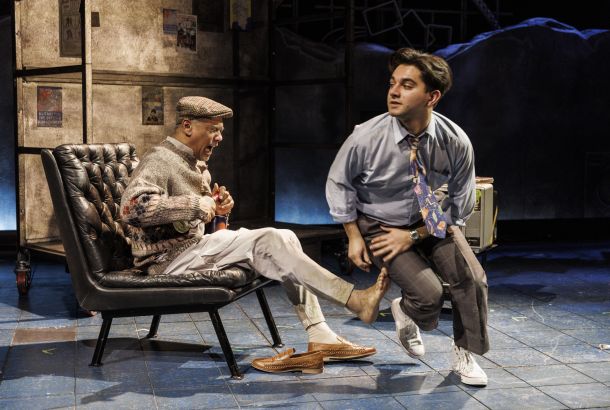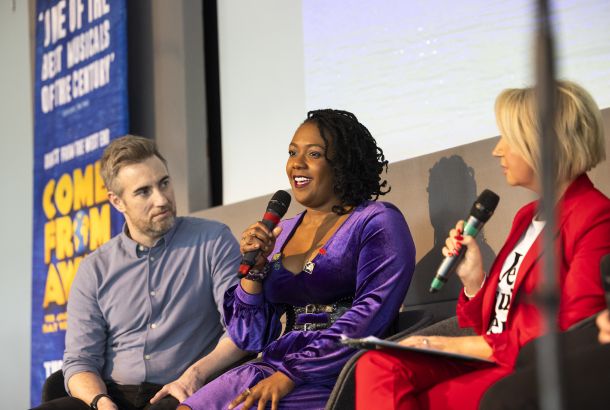In conversation with The Lion King’s Head of Masks and Puppets
By Imogen Mingos and Frances Briggs
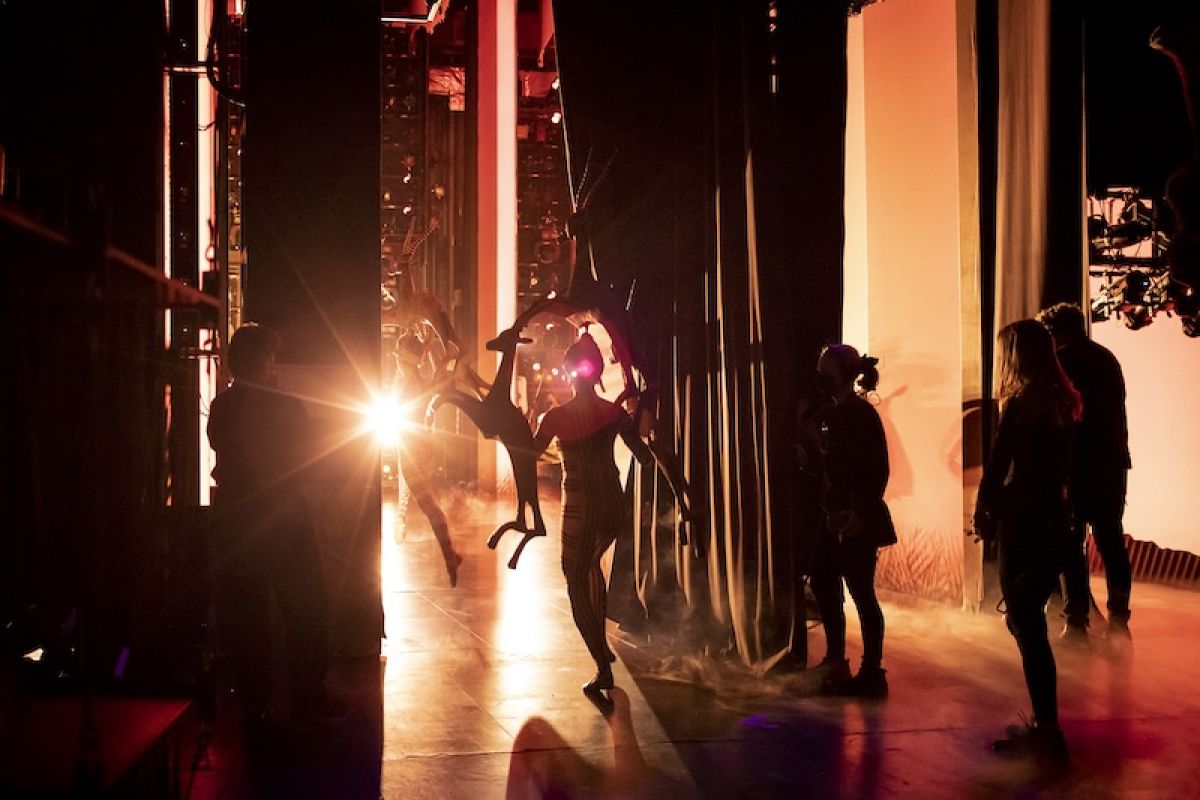
On the last dreary day of February, I set off for London from Manchester shortly after 7am. With caffeine in my system and a notebook full of questions, I was ready for the day ahead.
I was very kindly invited to the Lyceum Theatre for The Lion King’s first-ever Masks & Puppets Insight Session led by Joseph Beagley. Sat in the stalls were dozens of people ready to learn about the backstage magic which brings this beloved West End show to life.
From the moment he started talking, you could tell that Joe was passionate about his job. He spoke about all of the details and mechanics that we would probably miss in a live performance – the individually cut feathers for Zazu, the details on the gazelles which are etched in by hand, the carbon fibre masks which are painted to look like wood.
As Head of Masks and Puppets, Joe knows the ins and outs of this field better than most. He worked his way up to this position after he said he “fell” into this career early on after he “was savvy enough to walk through the first door,” he came across. Joe is evidently very proud and appreciative of how special his job is – values that he wants to instil in his team. Joe and five others are the crew trusted to work on the masks and puppets and to bring them to life for eight performances a week.
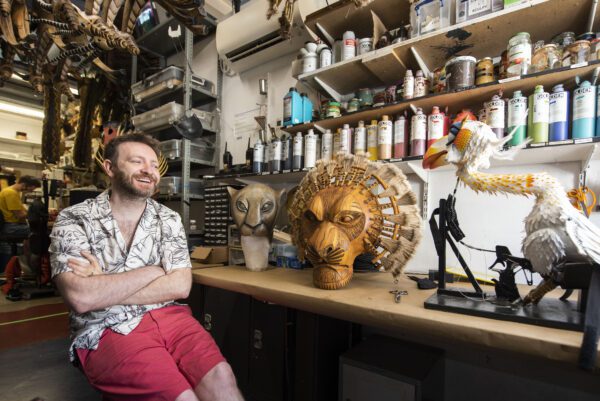
Most of the team’s work happens the day before the show, but they are still present during performances in case anything happens. When asked what the worst repair they’ve had to make during a performance was, fortunately, Joe didn’t have any horror stories, but he did say that it can be really disappointing if the elephant breaks and that they dread anything happening to Scar or Mufasa’s masks.
These are intricately constructed out of carbon fibre but painted to look like raw wood. Whilst carbon fibre is a popular lightweight material now used in everything from wind turbines to Formula 1 cars, in the mid-1990s when the show was being developed carbon fibre was novel, expensive, and the “height of technology”. To further decorate the headpieces, Scar’s mask is trimmed with goose feathers whilst Mufasa’s is adorned with bleached peacock fringe.
To differentiate them further, Mufasa’s mask is round and soft-edged whereas Scar’s is angular and sharper to aesthetically reinforce the opposition between good and evil. There is foam on the back for the performers’ comfort and head mounts made out of thermosetting plaster all of which is secured with a chin strip. The details don’t stop there, however, as the masks are connected to a motor underneath the actors’ costumes so they can be driven back to the tops of their heads to further convey characterisation.
Julie Taymor’s initial idea and a big reason behind the musical’s success is her concept of the ‘double event’. Her idea was to not try and hide anyone or anything by giving an illusion that the audience is watching a recreation of an African savanna, but rather for the audience to see the performers and puppets together.
This is achieved in two primary ways; the first is by having the masks and the puppets function as extensions of the characters rather than conceal the actors behind them. This is most obvious in Mufasa and Scar who change the positioning of their masks to convey either their human personas or their animal characters, for instance when they’re fighting their masks are upright rather than driven back. Secondly, to enhance this idea, the cast looks at the cast, and the puppets face the puppets.
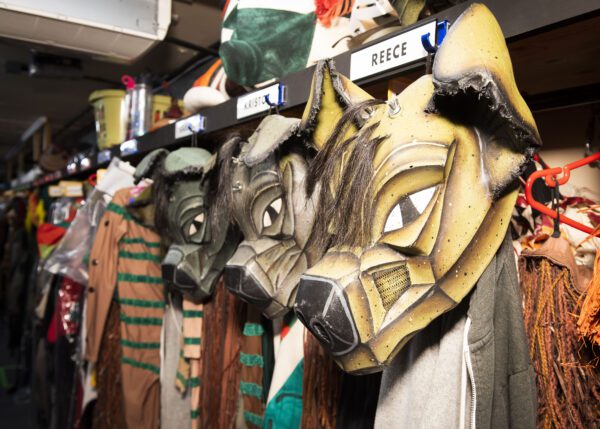
There are numerous puppets in The Lion King from giraffes to gazelles, anthills to elephants. Some of these probably look different to what you’d imagine a puppet to be; if you’re picturing Sooty and Sweep or Punch or Judy then prepare to be amazed.
The puppets are intricately designed so they are able to withstand the intensity of performances since they are connected to the ensemble members whilst also delivering visually. For instance, the giraffe heads are made out of predominantly carbon fibre except for the ears which are foam. They are repainted regularly to ensure that they look 100% at all times, but the carbon fibre means they don’t need frequent repairs.
Some puppets like the cheetah and the zebras have more complex mechanisms such as a ball and socket joint for the cheetah’s head and rod end bearings for the zebras’ heads. Their structures are covered in muslin and hessian, respectively, to add texture and detail. Whilst the cheetah is made from an aluminium armature, the rhino contains one-inch-thick steel tubes which are covered by shoulder pads for the performer’s comfort. Then there are the gazelles which need to be light for the performers’ leaps and dances – the repeated repairs can affect the finish and make the puppets too heavy, so they are replaced approximately every four years. There are even handheld shadow puppets made out of acetate which are operated by up to four people for a single puppet.
Joe’s personal favourite is Zazu who is most like a recognisable puppet as he is external from the performer and features rods and strings inside. Zazu is the most maintenance-heavy as Joe says it doesn’t take a lot for him to look “ropey”.
Most of the puppets’ mechanics haven’t changed much – if at all – since the first productions in the late 1990s, but the production of them has started to. The invention of 3D printing has revolutionised how Joe and his team work as they no longer have to produce everything by hand.
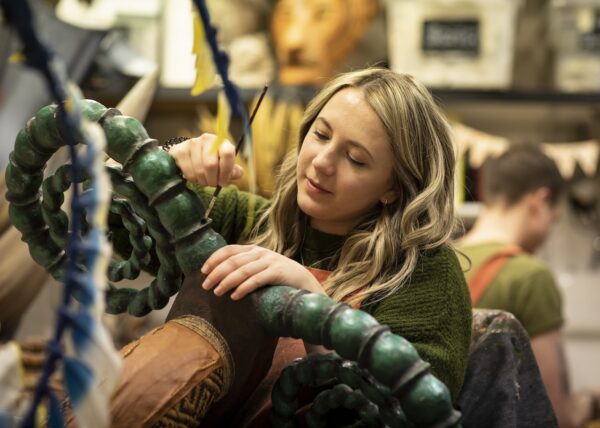
Learning all of this from the Insight Session was invaluable and, like Joe, I hope that this will be the first of many. Joe explained how The Lion King’s redefining of puppetry in the 1990s paved the way for a lot of other theatre productions like War Horse and The Life of Pi – they’re “trailblazers” and “not ashamed about saying that.”
After being shown the complexity of the puppets, it’s no wonder. The principal masks and puppets are bespoke to the cast and they all have to be uniform across every single production worldwide.
Joe was very candid about how when The Lion King opened in the West End in 1999, nobody expected it to last beyond five years. He revealed that three years on stage is considered to be successful in the industry and so the show’s initial designs were not developed with longevity in mind. Now, however, the team are looking forward to their next 25 years on stage; Joe hopes that The Lion King is only a half or a third of the way through its lifespan on the West End, but not without appreciating where they are now. When asked about the show’s long-running history, he said “We don’t take that for granted.”
This sentiment was evident from the amount of effort and care put into the masks and puppets week in and week out; getting the opportunity to learn about them first-hand and talk to Joe about his job was a privilege. Even when worn by audience members on stage, the masks and puppets looked spectacular and that is all down to the hard work of Joe and his team. I sincerely hope that The Lion King continues to amaze people in the West End for many more years to come and that the Lyceum Theatre is able to open its doors for more opportunities to learn about the masks and puppets in the future.
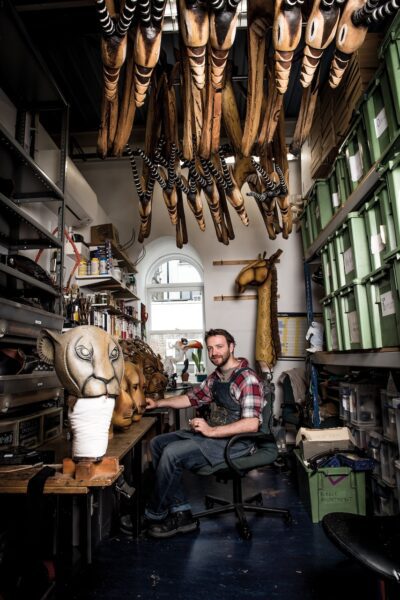
Backstage science and tech
Not your average hand puppets or dress-up masks, The Lion King production uses an array of techniques and materials to bring the animal puppets to life. Joe revealed some of the technology behind them:
Besides the carbon fibre, the puppets and masks are made from a myriad of materials which Joe reels off with the verbal dexterity you’d expect from the Head of Masks and Puppets. Among LD33 plastazote, liquid neoprene and scrim fabric, acetate is the only material which is familiar.
LD33 plastazote is a widely used foam, comprising of balloon-like nitrogen ‘cells’ supported in polyethylene. Not only is it durable, light and non-toxic, but it doesn’t absorb odours, making it an ideal material for long performances under hot stage lamps.
If you’ve ever worn a wetsuit then you have in fact worn neoprene, however, it has much more versatility than just keeping you warm when you go swimming in the UK. Chemically inert, it is long-lasting and water-resistant, making it a durable fabric for theatre.
Scrim fabric is perhaps the least exciting of these new-to-me materials. It is a grid-like cotton fabric which can be used in layers to add body to the masks and puppets. Using these materials, both cutting edge like carbon fibre or tried-and-tested staples like scrim fabric, enabled the incorporation of large-scale puppets into The Lion King whilst keeping them lightweight enough for actors to operate and perform with.
When asked what his favourite material is to work with, Joe maintains that the process of moulding and casting with silicon remains up there. If you’ve ever been on the DIY section of TikTok you may be more familiar with this – generally, it is a technique which involves creating a mould out of a silicon material which sets at room temperature but remains malleable, which then is replicated by pouring and setting another material into the mould. This makes making replicas a simpler process than building new parts from scratch.
Over 20 years and countless performances since The Lion King began, the Mask and Puppet team have fine-tuned the methods and materials they use to create a balance of durability, economy and ‘fixability’. One such change has been the implementation of 3D STL printing, swapping out hand painting. Doing so saves time and improves the uniformity of the pieces. STL (stereolithography) printing is a 3D printing technique using thermoset chemicals which react when exposed to light, polymerising to form the desired printed shape.
Joe’s insight session opened a window into the fascinating material science that enables The Lion King to incite awe in audiences and has kept them coming back since 1997.


